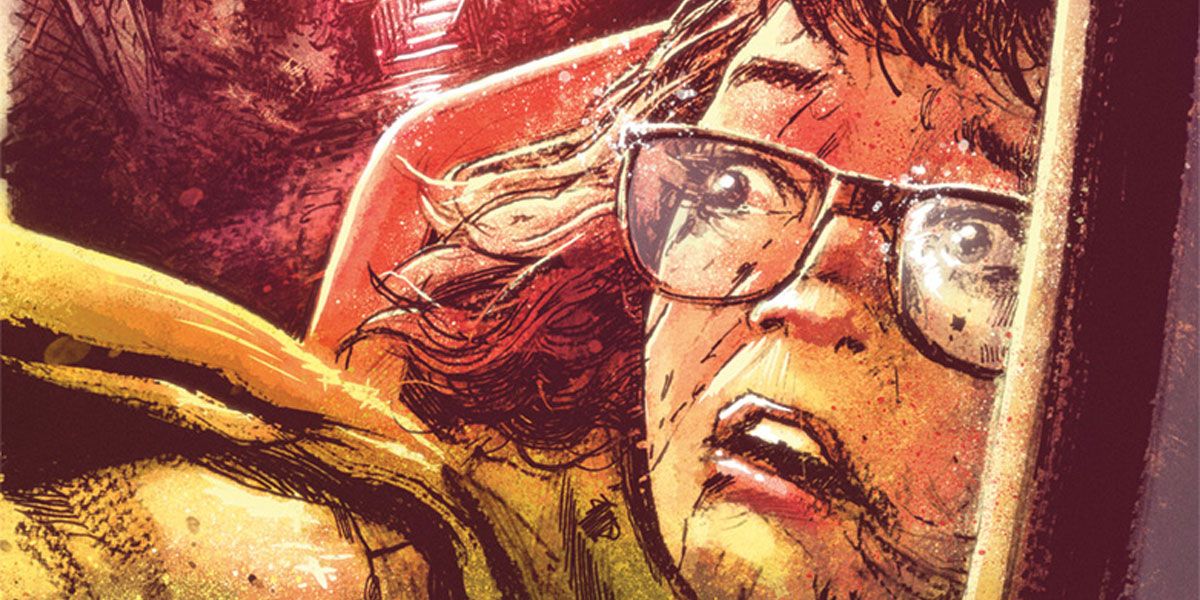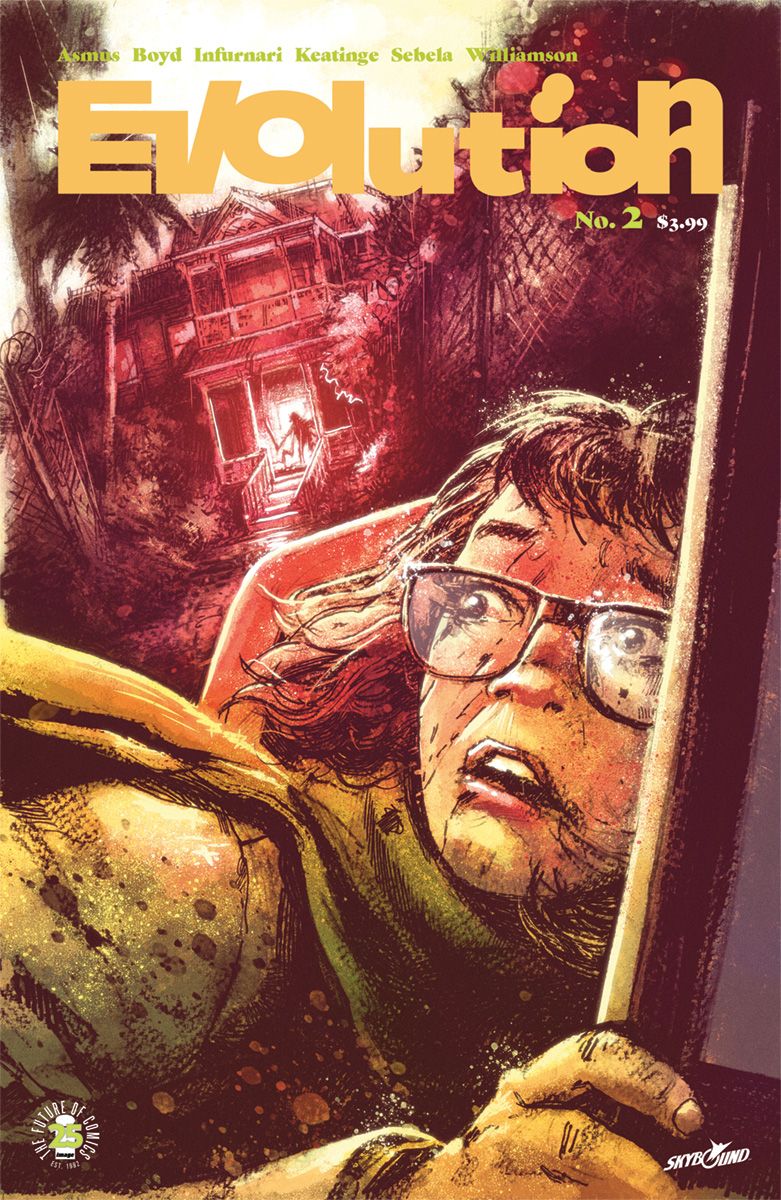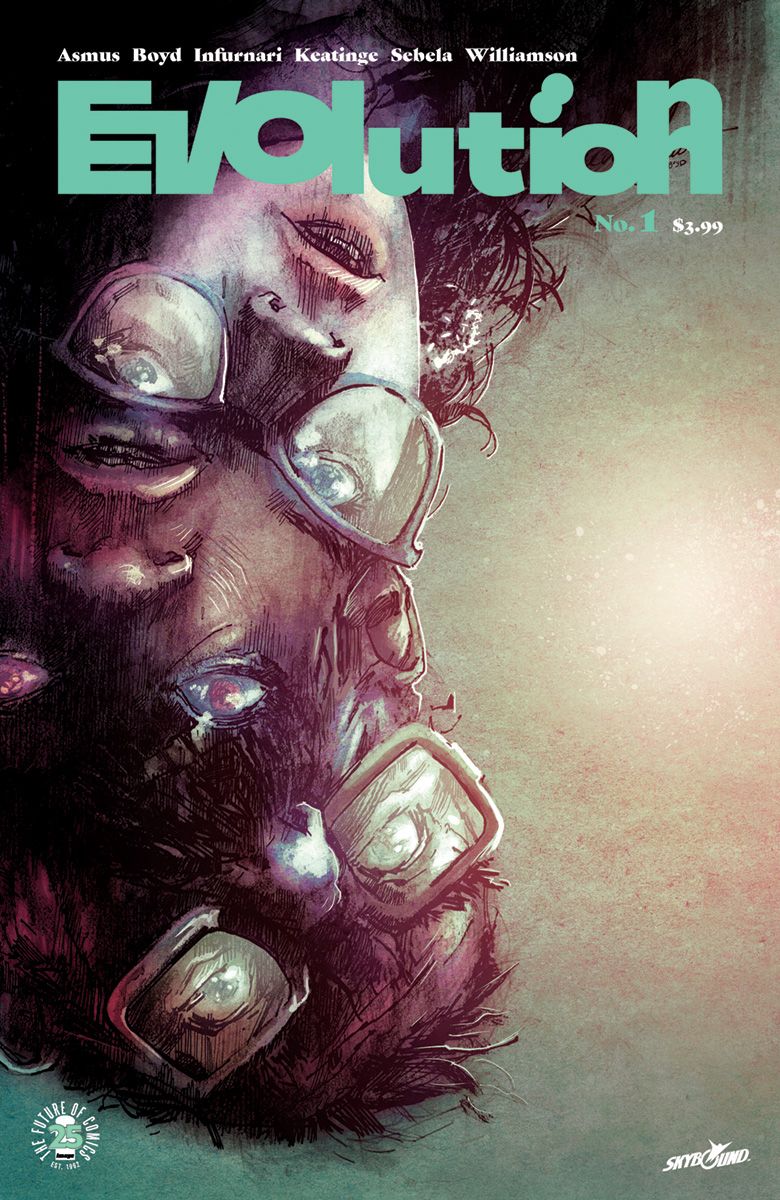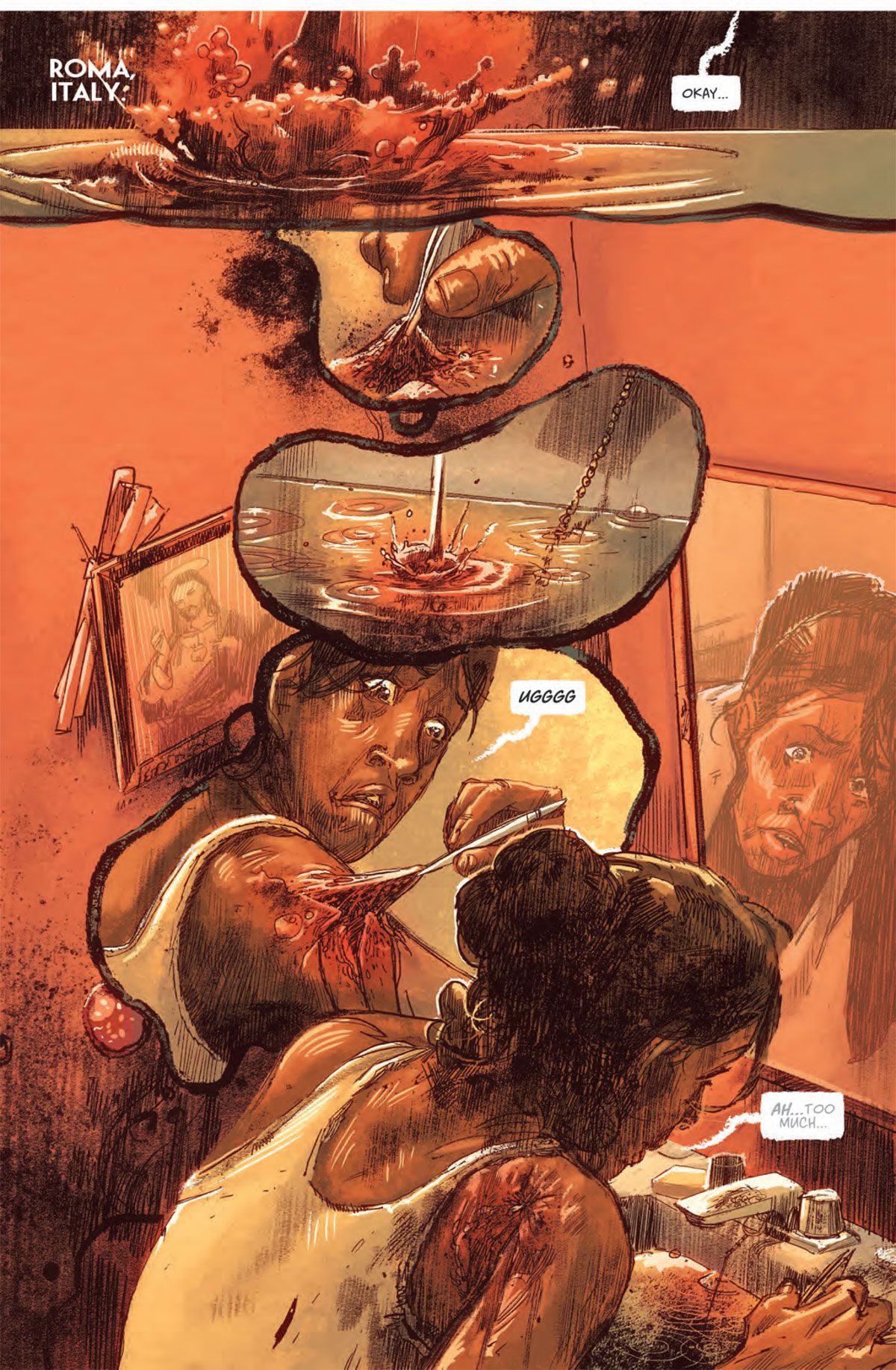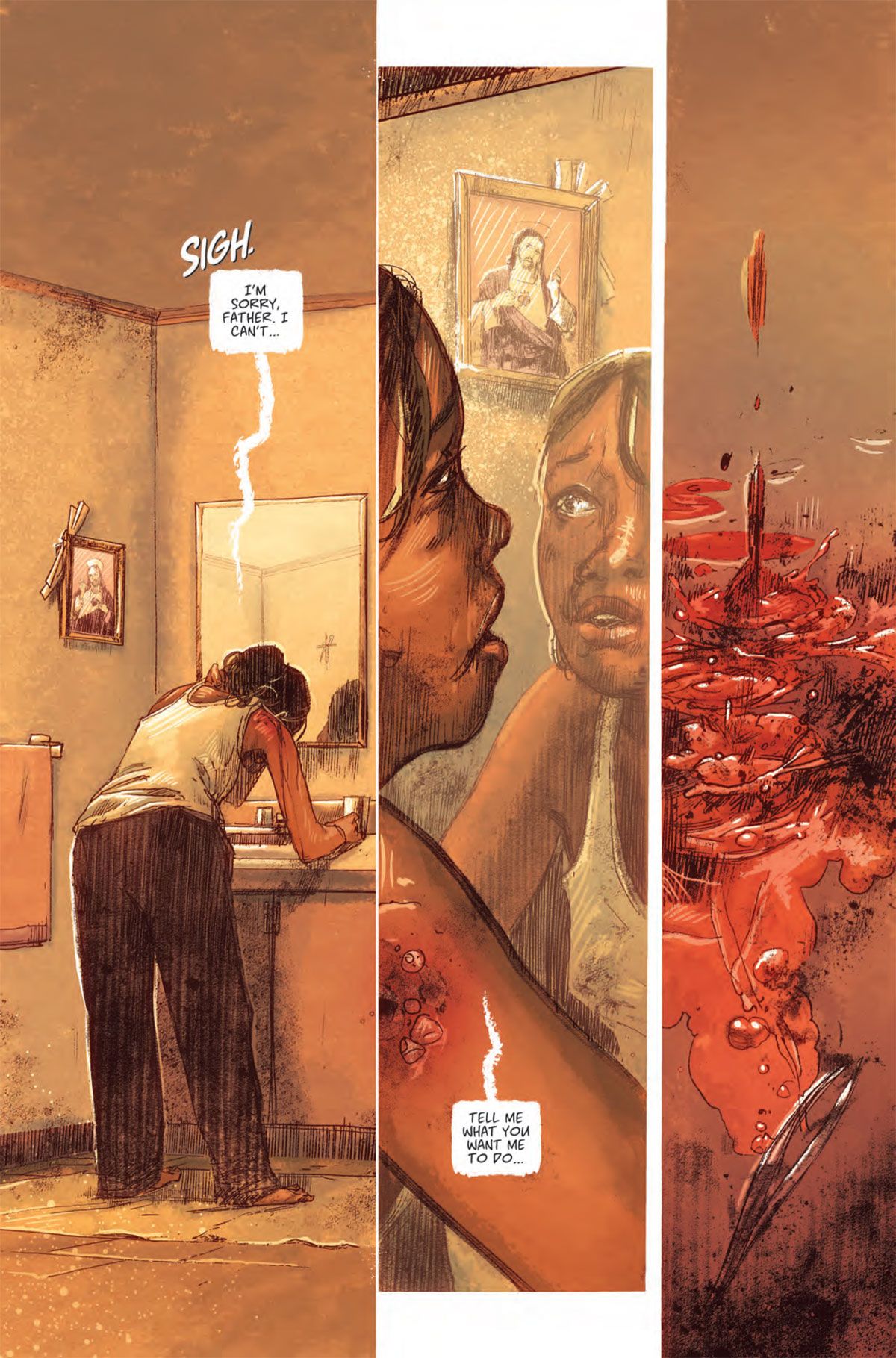Evolution, which debuted with its oversized first issue last month, was rushed back to print by Robert Kirkman's Image Comics partner studio Skybound. The new "body horror" series is generating positive buzz nearly as fast as the unpredictable changes that are affecting humanity in the book, from writers James Asmus, Joseph Keatinge, Christopher Sebela and Joshua Williamson.
Featuring art by Joe Infurnari and Jordan Boyd, the new ongoing series explores a monstrous global phenomenon, now driving human evolution, through the eyes of three individuals with very different worldviews: a scientist, a Catholic nun, and a young woman, who knows more about movie magic than math or misinterpreted mythologies.
RELATED: Skybound’s Gasolina Explosively Combines Crime Drama and Horror
With issue #2 (and the second printing of #1) out this week, CBR connected with Asmus, Keatinge and Sebela to discuss Evolution and learned all about the origins of the series, the scientific truths behind the storytelling and the power of keeping some secrets not only from characters, but readers too.
CBR: What is the secret origin of Evolution?
James Asmus: I'm not sure where the exact genesis of making an end-of-the-world book came from, I think Joe [Keatinge] may know better about that, but that's how it was pitched to me. We were going to do a writers' room type book with all of the writers in Portland so we could get together and break it down. And then we just had to figure out how the world ended [Laughs], which was the most exciting part for me because we've seen all of the apocalypse scenarios so trying to come up with something that wasn't covered ground was difficult but once we came up with the concept, I think we all really got excited about the possibilities and what we could do with it.
Joe Keatinge: As I recall, Skybound put two and two together in terms of us all living in the same city and said, "We have this cool idea. What do you think about it?" I love working with Skybound and thought Evolution was such a cool, weird idea and it was cool doing a book with multiple writers but with one artist and one colorist, being Joe Infurnari and Jordan Boyd. And I think it came out of us talking about horror and as I recall, we were all specifically into the body horror sub-genre and with us all knowing each other and being buddies, but it was, sorry to make a stupid pun, really just a natural evolution.
You mentioned a writers' room set-up. Are you rotating issue-to-issue, arc-to-arc, or writing specific characters? How exactly are the writing chores split?
Chris Sebela: First we sat down and decided the type of story that we all wanted to write within this larger story, and then we met up to bring it altogether. Since then, we meet up to do a grand review of what's going on over the next several issues. And we share what our next part of the story is going to be. We have a whiteboard and we break down how many pages we need each issue to tell our part of the story, and then we figure out how to weave our three perspectives in a way that feels natural. But the actual writing is basically the same. We just all go off and write our stuff. And I think we're all confident enough in each other's abilities where we're not looming over each other's shoulders all of the time.
There's a great line in the second issue of the series that says that evolution "used to be a slow, methodical defensive measure to adapt life to new condition. But now it's fast and brutal and playing offense." I know you are describing the central phenomenon in Evolution here, but I think it can be said that you are also summing up how humanity is trending today. It's easy to see if you take even a passing glance at your Twitter feed or watch two minutes of CNN. Would you agree?
Asmus: Yes, I certainly think that why we responded so much to this vision of the end-of-the-world as a horror story to tell is that despite not being explicitly topical, the emotion, the anxiety, the spontaneous chaos and violence -- I should say, the seemingly spontaneous chaos and violence -- feels like what it feels like to watch the news right now. And I think it's tapping into an essence of modern day life anxiety and fear without having to get into the weeds of arguing political points.
Sebela: I feel like once you have a sense of being around for a while, things start to feel like they're speeding up. I think a lot of that did inform, at least on my end, the writing. It feels like another year is over or just how quickly we get used to all of these horrible things that are happening around us. We're tapping into that too. We're depicting a world where this massive change is happening but everybody is still going on with their lives and trying to pretend like everything is okay.
Keatinge: You guys are so dark. [Laughs] Every generation thinks they are going to be the last. I think it's just something inherent to the human race. The world is changing and how do we possibly keep up? Sure, Evolution is about the human condition and understanding our place in the world but I think that's what good horror is. Tapping into what people feel and fear and exploiting that for all it's worth. [Laughs]
As stated, Evolution is published by Skybound, which is also home to co-founder Robert Kirkman's groundbreaking Walking Dead series. After 173 issues, Robert has yet to reveal how the outbreak started in Walking Dead and how the zombies came to be. And nobody cares, because it doesn't play a part in the storytelling. In Evolution, will we learn about the cause of the phenomenon sweeping the globe?
Keatinge: I think one of things that really appealed to me, and I think all of us, is that we wanted to explore this thing from a lot of different directions. Could it be supernatural? Could it be science? Could it be religious? Could it be just monsters? And in asking the questions, that's where you get the real answers. [Jack] Kirby talked about that a lot. In his career, he said that asking the questions is the thing that fulfills him. And that fulfills me. We do have the answers but it's in asking the questions that we get the real meat of the story. We have it all figured out and we know there are people that want to know every answer to every question to every single thing that they read or watch but I think what really appeals to me about this story is exploring all of these potential answers and we go from there.
Asmus: There are some answers in the series and we mapped out the hows and whys for ourselves but like Joe said, especially using the split narrative approach -- following these different characters -- allows us to explore all of the different possible answers. We follow a doctor, a man of science, and a woman of faith, which gives us at least two different ways to search for answers. It's about looking at different ways of filtering horrible things that are happening into your worldview and figuring out how you cope with them through your belief system and how you look to move forward and push back against them. And I think that interests us more than laying it out like some kind of sterile prequel that would just tell you everything and suck all of the mystery out of it. Like I said, there will be some answers but to us, it about responding to baffling horror and remembering that wanting answers and getting answers is not always the same thing. I think what we can't figure out is usually more genuinely more horrifying than something that has been explained away.
Page 2: [valnet-url-page page=2 paginated=0 text='Body Horror, Setting and the Real-Life Science of Evolution']
We get some pretty incredible monster mutations in Evolution. The genre of "body horror" is sacred ground for fans of David Cronenberg and the like. What makes body horror so intriguing as creators?
Sebela: I'm such a big horror nerd and I tend to dwell on the function of monsters and what purpose do these sorts of mutations serve. That was a thing that was really high on my list because with Evolution, we didn't just want to have a monster with 50-million teeth for no reason. All of the mutations and monster-isms that we came up with were natural extensions of what we supposed a lot of Evolution would be dealing with. I love doing nuts and bolts stuff like why does this monster have four eyes? Or in the first issue, why does this kid have gills? That's the fun part of doing horror, getting to build that stuff from scratch.
I used the mighty powers of Google translate and discovered that one of the monsters' war cries "PRAEGRESSUS" means "gone ahead" in Latin, which makes perfect sense when the story is about evolution.
Asmus: Yeah. Someone did the work! But if you put that in this interview, you're just giving away all of your hard work.
I'm a man of people. [Laughs] That said, when I did the same for "KAVALLIS," the best I could find was "foolish" or "in the café" in Lithuanian. Am I close to cracking the code or at least a code here?
Asmus: That's probably more of an accident.
Keatinge: Speak for yourself. [Laughs]
When Dr. Abe Hurley, one of your main characters, is speaking on the phone with a former colleague about the evolution or phenomenon currently underway, the person on the other end talks to Abe like he is a conspiracy nut, calling his theory a "doomsday virus" while comparing Abe to Chicken Little because "the sky is falling." Citing Y2K and the bird flu as comparable overreactions, it would appear that the evolution is in its nascence and that Abe's findings are groundbreaking. Is that right?
Sebela: It depends on which story we're on. Definitely in Abe's part of the story, we're dealing with a world that's not up to speed about what's happening. Abe feels very much like Chicken Little running around trying to tell everybody what is happening but in the other storylines, there is more progression. That was our take from the beginning. We didn't want everyone starting at Step 1. Certain storylines are a bit further along, even if the main characters don't necessarily know what's going on, we're giving more to the reader in different storylines and hopefully it all comes together to answer enough questions yet still be mysterious enough to keep readers coming back.
Abe represents science and Sister Hannah obviously represents the religious version of these events. There is a third main character named Claire, who is a bit more like the rest of us. Her parents owned a vintage movie business in Hollywood and she seems to be just as confused and horrified as "regular folk" would be under the circumstances, especially when a former patron of her parents' store, who reminds me of Vincent Price, comes looking for some old scary movies. Is she your everyman?
Keatinge: That's right. I think you nailed it. Claire and Rochelle are just regular women, living their lives, but then they find themselves dealing with this extremely bizarre situation. And yeah, there is an old Vincent Price/Russ Meyer type of a character that the world has kind of passed by and he opens up this world of evolution to Claire and Rochelle. I grew up in Los Angeles and it was really weird because you would end up playing kickball with Chevy Chase's kid or a kid's mom was Meredith Baxter from Family Ties. Growing up in Los Angeles, there was always this kind of weirdness. You weren't really part of the Hollywood scene but having it interact with you was always there, and it definitely fueled a big part of the uneasiness of these two characters. They're just two regular people that have been dropped into this really bizarre situation. Beyond that, LA is just a weird place and I've always wanted to set a story there.
And LA is definitely a weird place in this story because if you are going by the found footage that appears on some of the vintage reel-to-reel film that Claire and Rochelle find, it would appear that LA may be a nexus point for the evolution, because this type of film hasn't been used for some time.
Keatinge: We have three, well four, characters including Rochelle, who are united by this situation coming at it from all different perspectives. And where they all go from there is what Evolution is all about.
I read a while back that we may only be a few generations away from our children no longer being born with pinky toes. And as a redhead, I have also heard that gingers may be going the way of the dodo bird. How much real science is in Evolution?
Sebela: In a lot of the research that I have done for the series, there are a lot of evolutions happening these days. But they are very specific. Doctors, who do a lot of x-rays, something happens to their bodies where they develop a resistance to that type of radiation because their exposure to it. I wish we would. I think it would be interesting.
Asmus: There is documented proof of massive rises of autoimmune conditions in people and there is admittedly a degree or debate about whether or not we are just actively aware of them now and are getting better at finding them and identifying them, or really they are just happening so much more. But in a post-industrial revolution world, I wouldn't be surprised to find out that our bodies are struggling to cope with changing air and water. And our diet has become completely unnatural over the past 100 years. There has to be reactions to that but how quickly we can cope and advance in a beneficial way as opposed to just getting cancer is the question.
Keatinge: Earth is obviously evolving fast. In part because of the damage that humanity has done to it. And for me, that's actually inspired me more for this than the idea that people are actually evolving. Obviously, the world is evolving and it's evolving towards an environment that humanity can't exist in. The question becomes: "There are bigger things happening without you, so what are you going to do? Grow gills?" [Laughs]
RELATED: Kirkman, Vigalondo Team To Adapt The Comeback To Film
Finally, the art in this series in fantastic and while there is a writers' room mentality for the story, the art is remaining consistent with a regular artist, correct?
Keatinge: That's right. We talked early on about having one vision for this and having one artist for it. I know Joe Infurnari and when I found out that he was looking for work, I was like, "He's the guy!" Looking at his stuff, you knew he'd perfect. Look at his work in The Bunker. It's as creepy as all hell. I knew he would be adaptable to any sort of situation and he would be perfect for Evolution. And Jordan Boyd is amazing. He can really change a mood by just tweaking the colors. While it reads as one cohesive whole, Jordan lets the reader know instantly that the environment has changed through his coloring. And Pat Brousseau is an incredible letterer. I love what he is doing in respect to the word balloons.
Asmus: Pat put a lot of love and thought into crafting a different word balloon template for this series because he wanted it to meld better with the more rushed and uneasy style that Joe and Jordan were creating with the art. That is the level of thought and care into world-building and tone and feel that I think helps give this book so much atmosphere and such a real feeling of horror and dread even in the quiet moments. They [Joe, Jordan and Pat] do such incredible work creating the atmosphere so the book reads like a horror on every page.
Sebela: Personally, Jordan is a friend and I have wanted to work with him for a long time and I love his work just as much as I love him as a person. I like to surround myself with good vibes people and that's what we have on Evolution.
Evolution #1 (second printing) and Evolution #2 are both available on Dec. 20.

